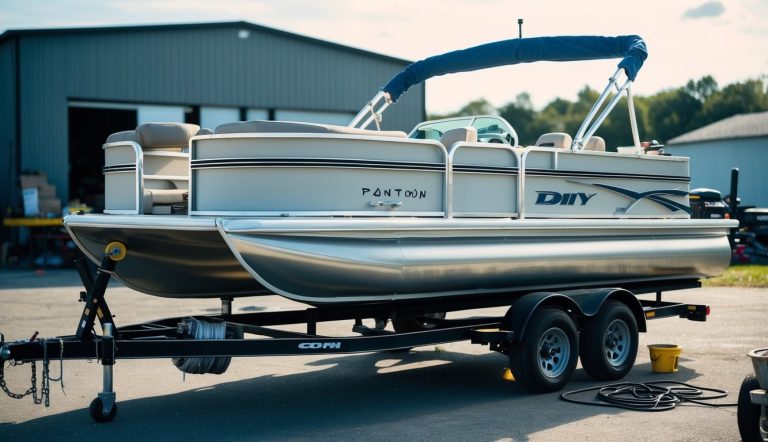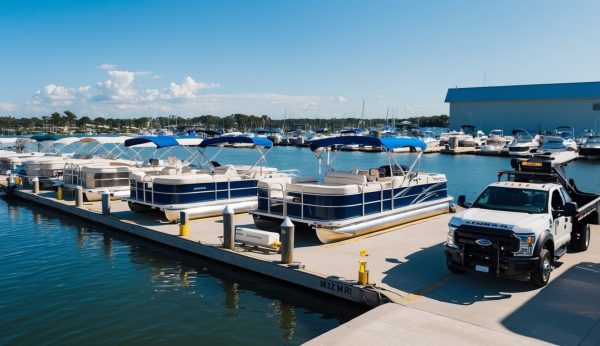Moving a pontoon boat from one place to another can be a challenging task. You have two main options: doing it yourself or hiring professionals. Each choice comes with its own set of advantages and challenges that you should carefully consider.
When deciding between DIY pontoon boat transport and professional services, your choice should depend on your budget, experience level, and comfort with handling large watercraft equipment. Understanding the pros and cons of both approaches will help you make the best decision for your specific situation and ensure your boat arrives safely at its destination.
Cost-effective DIY solution
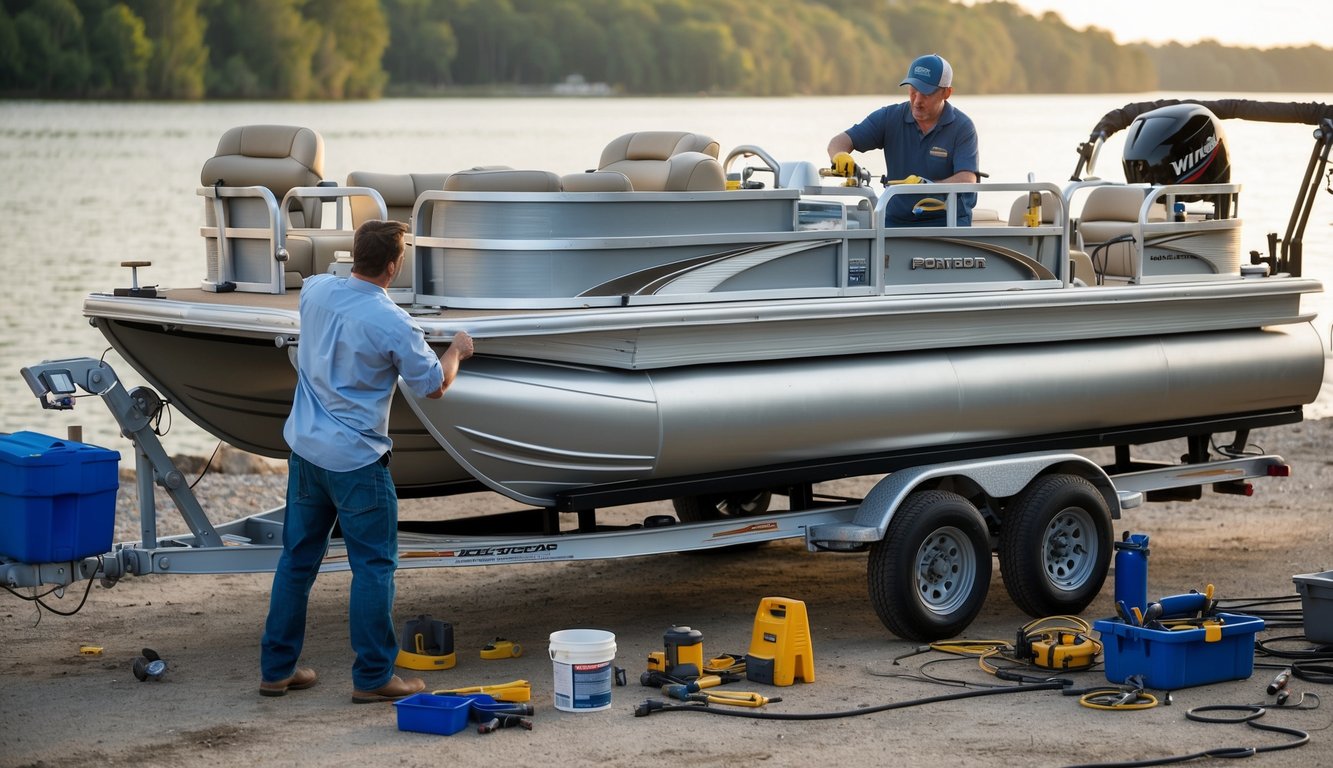
- Transporting your pontoon boat yourself can save you significant money. Professional transport services often charge hundreds or even thousands of dollars depending on the distance.
- With the DIY approach, you only pay for fuel and any necessary equipment. You might need to invest in a utility trailer which costs between $400-900 new, but this is a one-time expense.
- If you already own a suitable vehicle and trailer, your costs drop even further. Many pontoon boat owners find that a pickup truck or SUV works well for towing their boat.
- You can also customize your transport setup to fit your specific needs. Some boaters create custom trailers that perfectly accommodate their pontoon dimensions.
- The DIY method gives you complete control over timing and scheduling. You won’t have to work around a transport company’s availability or pay rush fees for last-minute moves.
- While DIY shipping offers a sense of control and can be cost-effective, it’s important to weigh these savings against your time investment and any potential safety concerns.
Control over the entire process
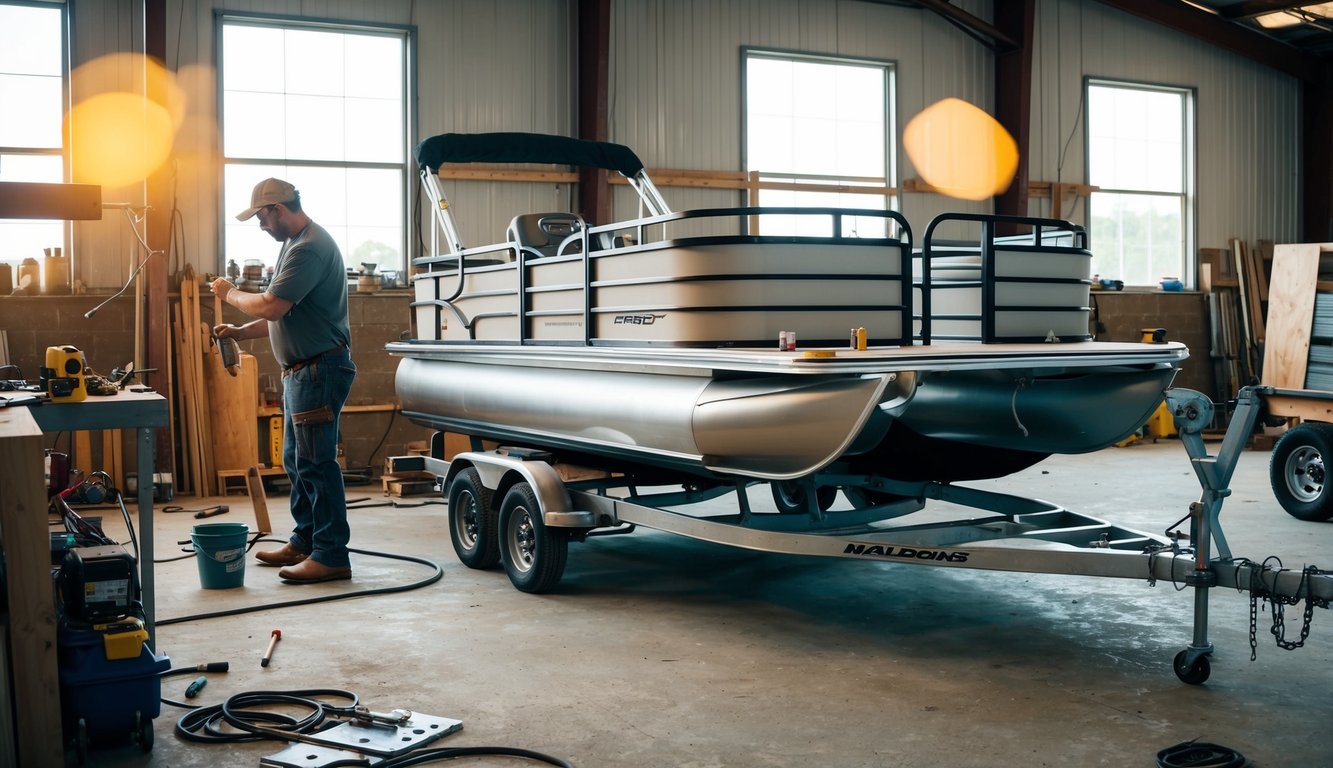
- When you choose DIY pontoon boat transport, you gain complete command over the entire process. You decide when to move your boat and which route to take, without depending on someone else’s schedule.
- You can take extra precautions with your valuable watercraft. Many pontoon owners prefer handling their boats personally to ensure proper care during transport.
- Setting your own timeline means you can work around weather conditions. This flexibility lets you avoid transporting your pontoon during storms or high winds that might damage it.
- You can also make stops along the way if needed. Whether it’s for a break or to check that your pontoon is still secure, DIY transport gives you that freedom.
- The ability to put your pontoon together yourself means you become familiar with all its components. This knowledge proves useful for future maintenance and troubleshooting.
- Remember that this control comes with responsibility. You’ll need to learn proper securing techniques and transport regulations to ensure safe travel.
Customization Potential

- When you transport your pontoon boat yourself, you gain the freedom to customize the experience to your specific needs. DIY transport allows you to choose your own route, timing, and stops along the way.
- You can take the opportunity to add custom seating options or make other modifications during the transport process. Many boat owners use this time to install new features before reaching their destination.
- The flexibility of DIY transport means you can accommodate special requirements for your vessel. If your pontoon has unique appearance upgrades like custom graphics or decorative panels, you can take extra precautions to protect these features.
- You also have the ability to adjust your transport setup as needed. This might include special tie-downs, custom covers, or additional padding for sensitive areas of your boat.
- DIY transport enables you to make immediate decisions if weather conditions change. You can choose to delay your journey or take shelter, protecting your investment on your terms rather than following a professional’s schedule.
No professional fees required
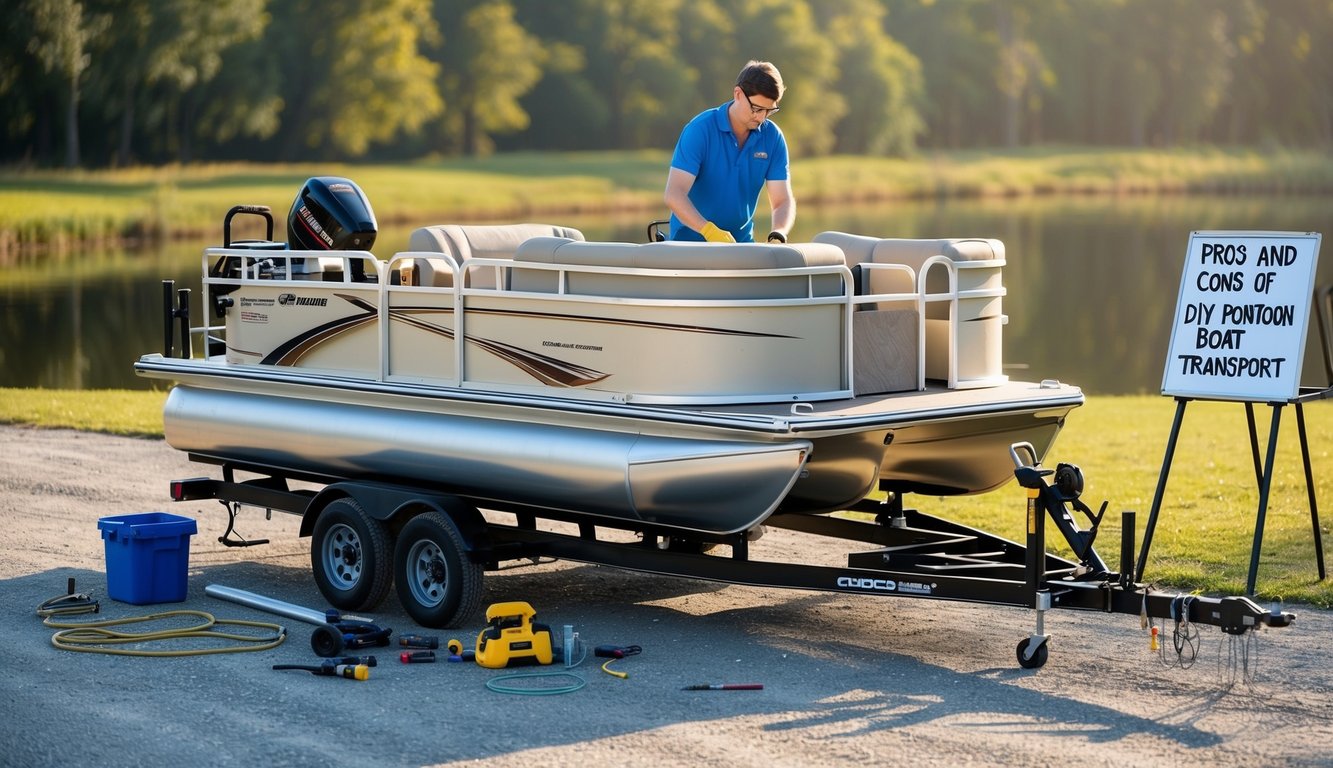
- When you transport your pontoon boat yourself, you can save money by avoiding service fees. Professional boat transporters charge for their expertise, equipment, and time.
- These fees can add up quickly, especially for larger pontoon boats or longer distances. By handling the transport yourself, you eliminate these costs completely.
- You pay only for the essential expenses like fuel, trailer maintenance, and any permits needed for the journey. This direct approach can be particularly cost-effective if you already own a suitable vehicle and trailer.
- The money you save can be used for other boating expenses like maintenance or upgrades to your pontoon. Many boat owners find that DIY repairs and transport are key ways to reduce the overall cost of boat ownership.
- Remember that while you avoid professional fees, you’ll need to invest your own time and effort instead. For many pontoon owners, this tradeoff is worthwhile, especially if you enjoy hands-on projects and have some experience with towing.
Possible safety hazards
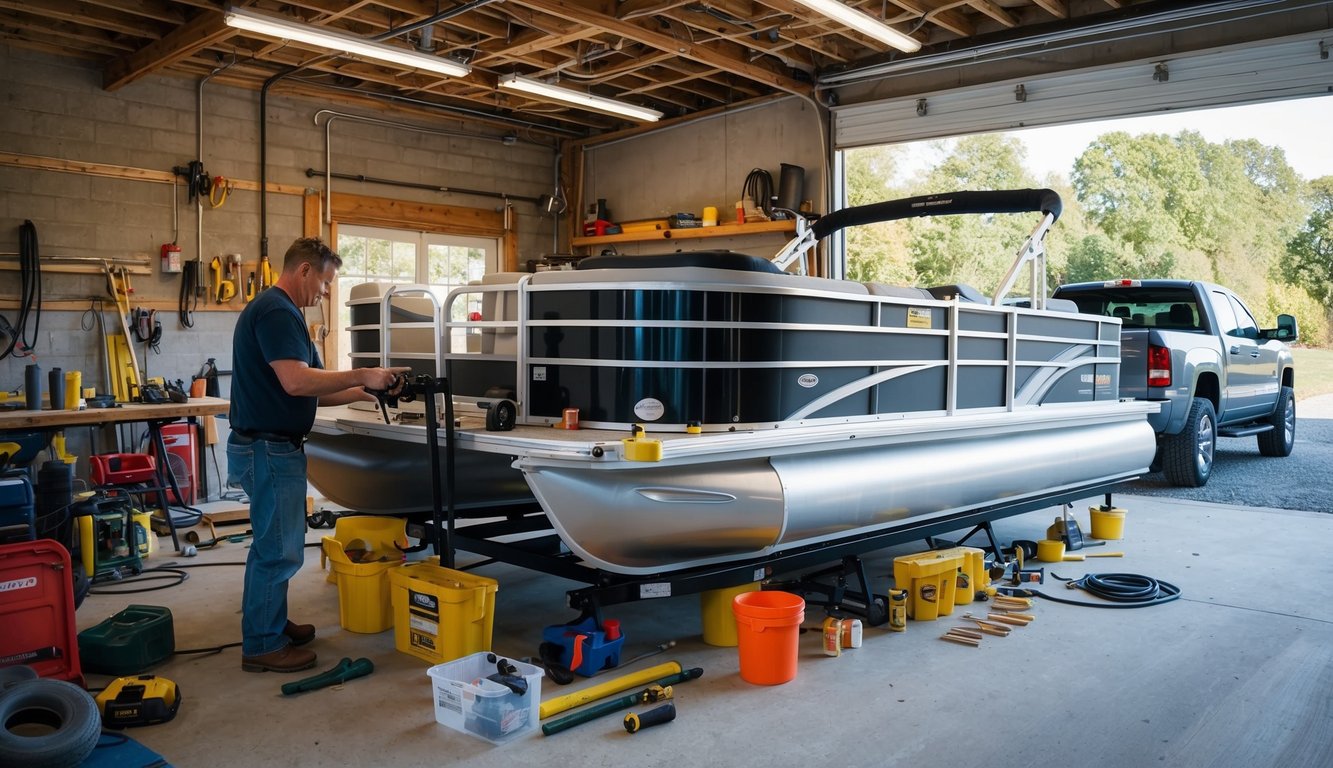
- When transporting a pontoon boat yourself, you should be aware of several safety risks. Carbon monoxide buildup can occur if your engine is running during transport preparation, which poses a serious health hazard.
- Improper securing of the boat can lead to shifting during transport. This creates dangerous road conditions for you and other drivers, especially on highways or during sudden stops.
- Without professional expertise, there’s a higher risk of transportation errors that could damage your vessel. Pontoon boats have thin aluminum tubes prone to punctures, making them particularly vulnerable during DIY transport.
- Weather conditions present another hazard. High winds can catch the large, flat surfaces of pontoon boats, making them difficult to control on the road.
- Inadequate knowledge of height restrictions may lead to collisions with bridges or overpasses. Always measure your load height before departing.
- Improper weight distribution on your trailer can cause dangerous swaying or even trailer detachment. Make sure to balance the boat properly and check all connections before driving.
Challenges with securing loads
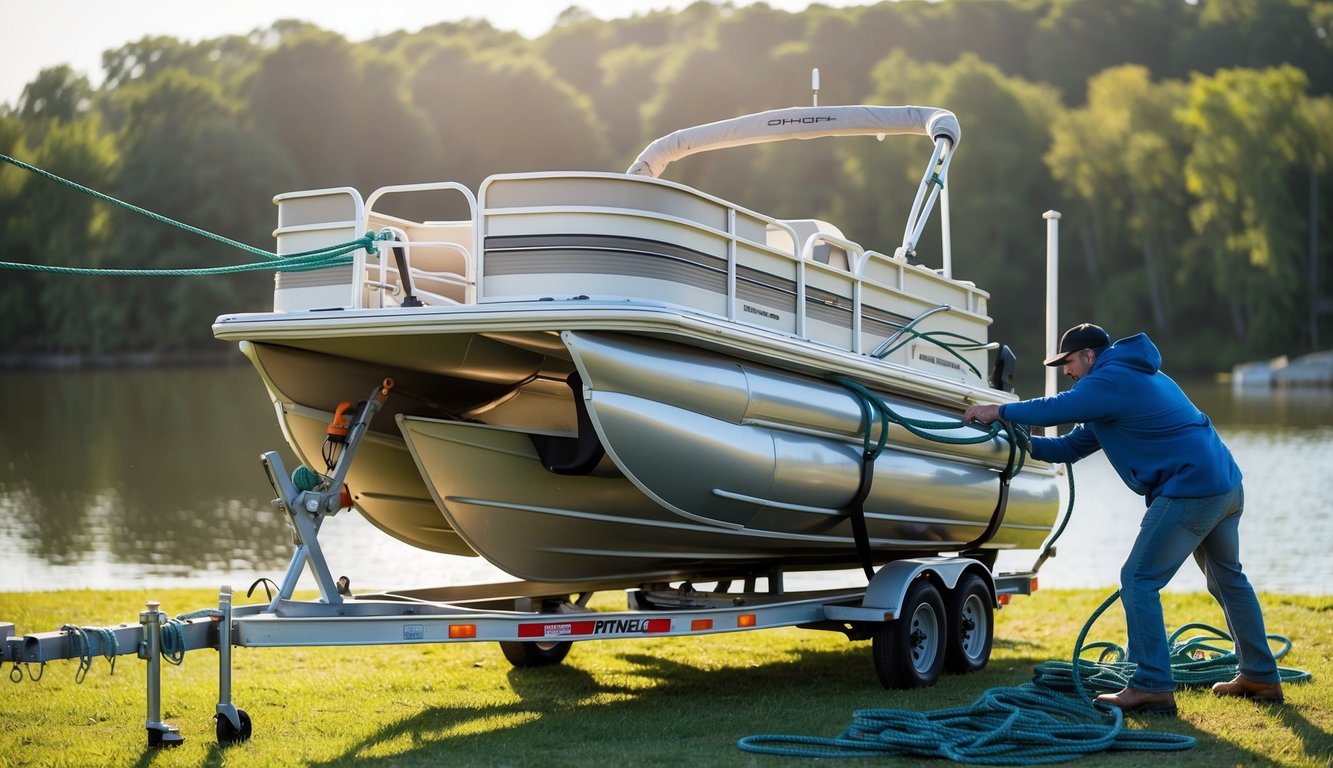
- Properly securing your pontoon boat for transport is critical but comes with several obstacles. Wind resistance is a major concern for pontoon boats due to their large, flat surfaces that act like sails.
- Pontoon boats have complicated lifting and trailering requirements compared to regular boats. Their unique structure means standard strapping methods often aren’t sufficient.
- You need specialized straps designed for the tubular shape of pontoons. Regular tie-downs may slip or create pressure points that damage the aluminum tubes over time.
- The weight distribution of pontoon boats creates another challenge. Uneven securing can lead to shifting during transport, potentially causing damage or dangerous road conditions.
- Weather conditions compound these difficulties. Rain can make straps loosen while strong crosswinds can test even the best securing methods due to the boat’s vulnerability to wind.
- For DIY transport, you’ll find it time-consuming to properly secure the load. Each strap must be positioned correctly and checked regularly during transport to prevent accidents.
- The large, awkward shape of pontoon boats requires careful measurement to ensure nothing extends beyond legal width limits for road transport.
Limited towing experience
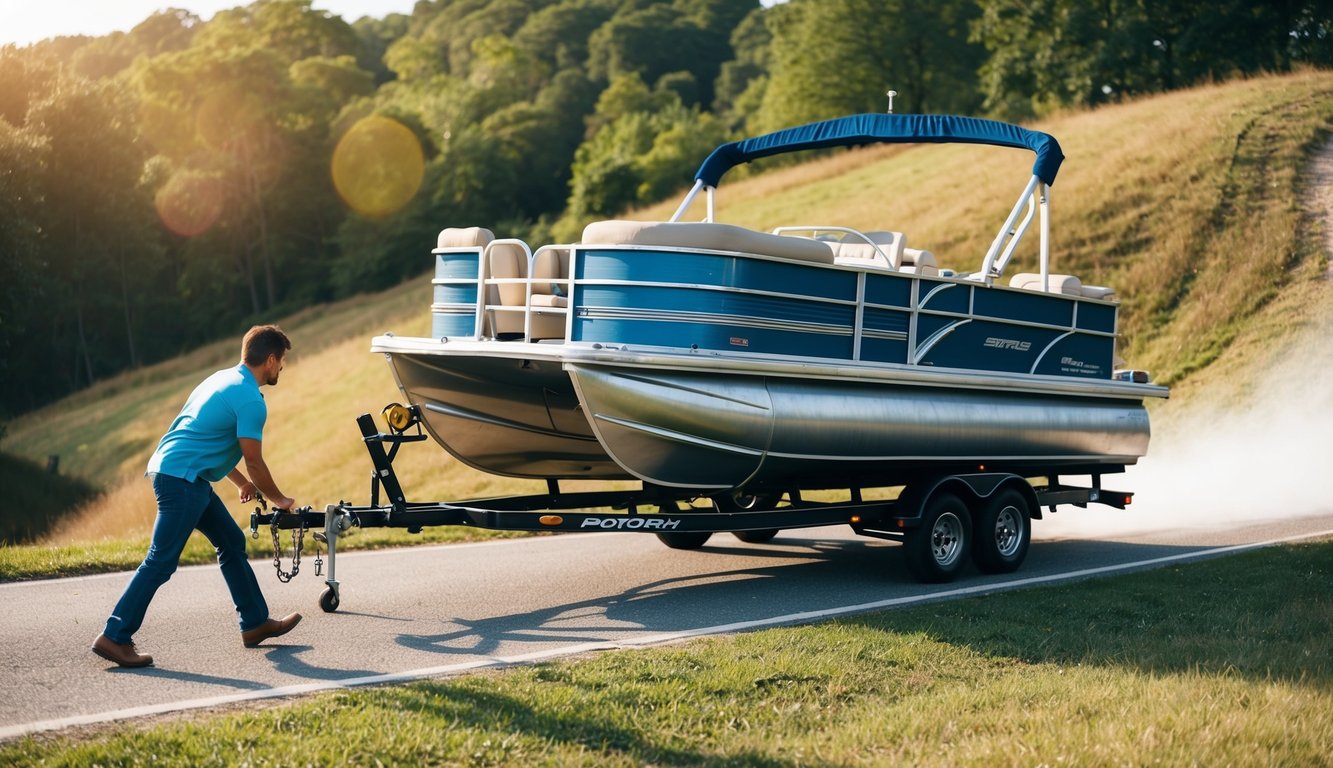
- If you’re new to towing pontoon boats, there are some challenges you should know about. Pontoon boats have a unique shape that makes them harder to tow than V-hull boats.
- The flat, wide design of pontoons creates more wind resistance. This means you’ll feel more drag when towing a pontoon compared to standard boats.
- Without enough experience, you might struggle with backing up the trailer. Pontoons require different steering techniques at launch ramps, and you need to be confident when guiding them into tight spaces.
- Weather conditions can make towing more difficult. Strong crosswinds affect pontoons more severely due to their large side profile.
- Learning proper loading and launching techniques takes practice. You’ll need to understand how to secure the boat properly and manage its weight distribution.
- Professional boat towing services exist for a reason. They have the experience to handle challenging situations that might be dangerous for beginners.
- With practice, you can improve your skills. But be realistic about your current abilities before attempting to transport your pontoon boat yourself.
Time-consuming preparation
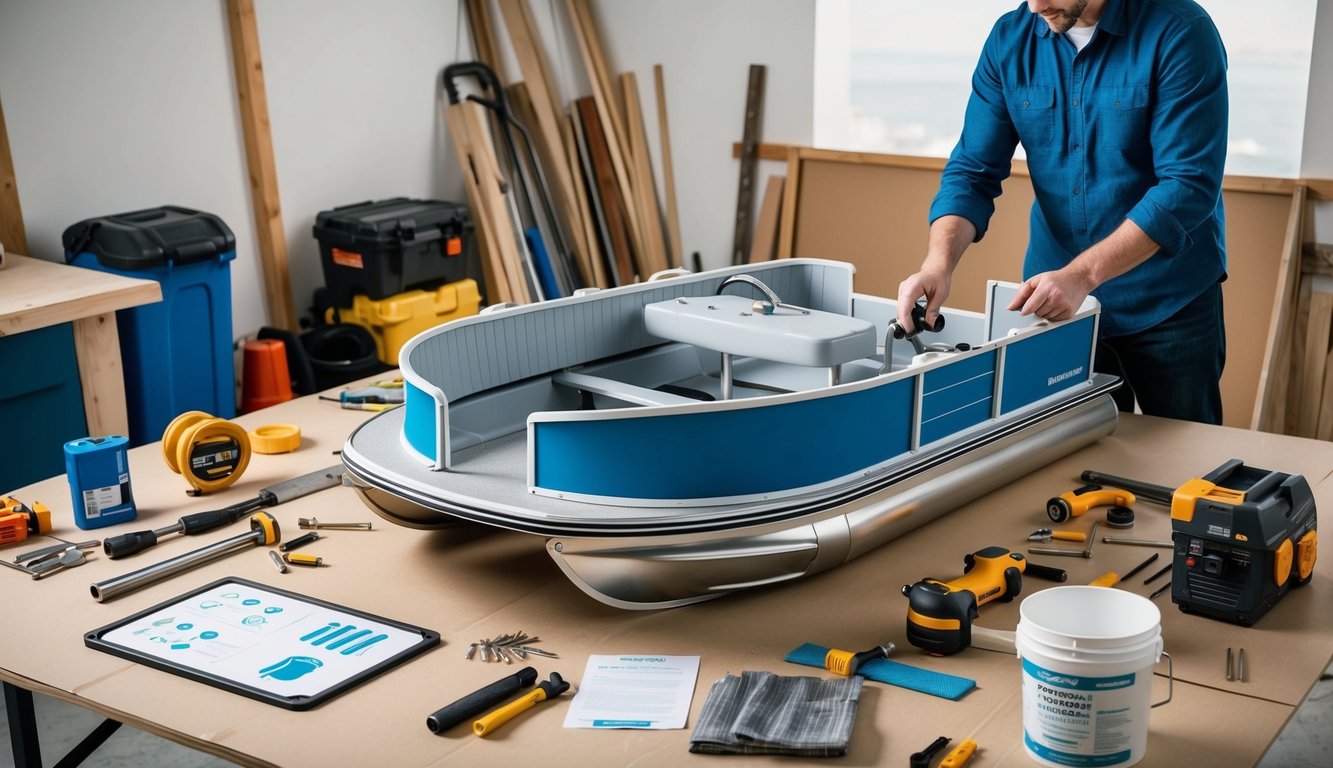
- Getting your pontoon boat ready for a DIY transport takes much more time than you might expect. DIY boat shipping means diving deep into every detail, which can eat up hours of your day.
- You’ll need to secure all loose items and remove anything that could fly off during transport. This includes covers, electronics, and personal items that might be stored in compartments.
- Proper strapping requires careful attention to ensure your pontoon won’t shift during travel. You’ll need to check and double-check all tie-downs before hitting the road.
- If launching at a busy ramp on weekends, preparation becomes even more important. Using that extra waiting time to get everything ready can save stress later.
- Some pontoon owners report that practice is essential for efficiency. Try to get your setup time down to twenty minutes or less with regular practice.
- Route planning also takes considerable time. You’ll need to map out roads that can accommodate your wide load and identify potential hazards before starting your journey.
- Permit acquisition can be another time-consuming process depending on your boat’s size and the distance you plan to travel.
Potential stress during transit
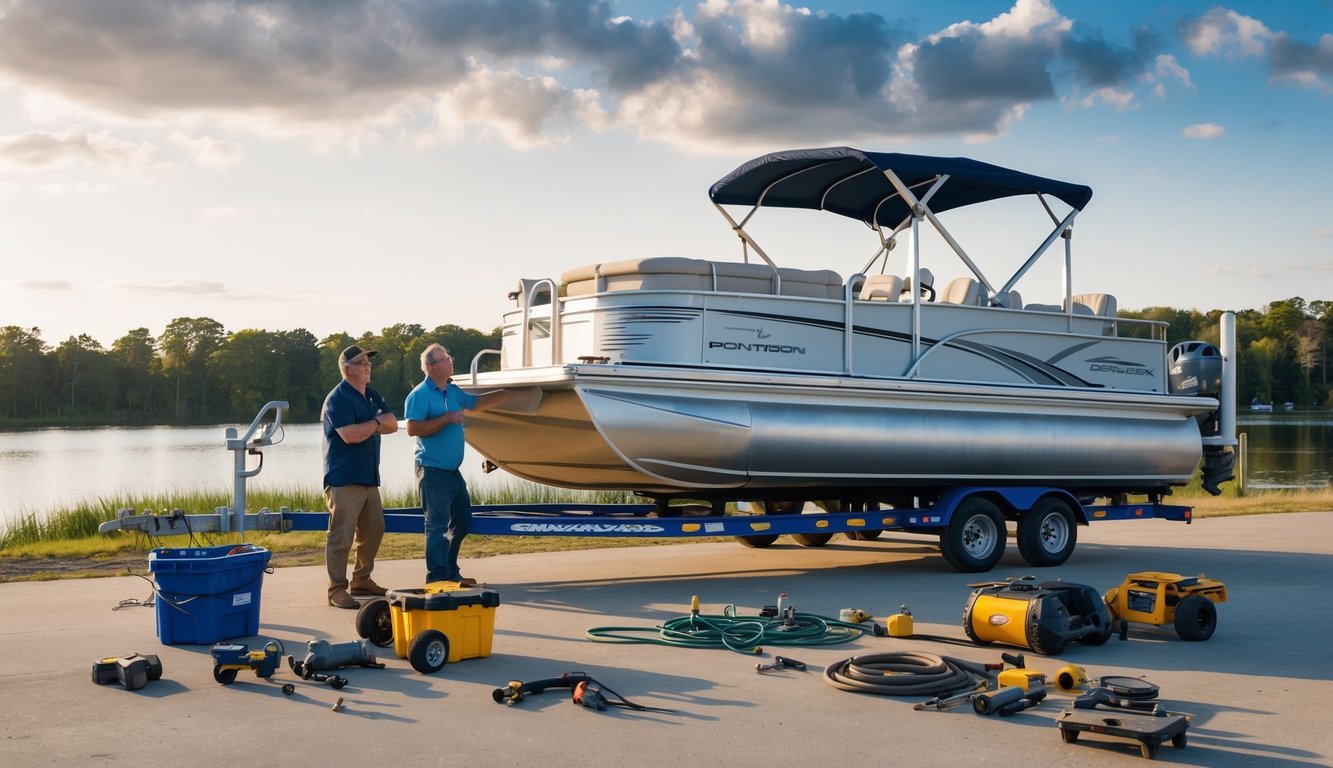
- When transporting a pontoon boat yourself, you need to be aware of how stress can affect your vessel during the journey. Your boat’s transom is particularly vulnerable to damage while trailering.
- A transom saver is a device designed to protect this area from undue stress. Without it, the constant bouncing and vibration on the road can damage this crucial part of your boat.
- Your pontoon’s structure faces different stresses than V-hull boats. The flat, wide design makes pontoons especially vulnerable to crosswinds and wave action when in transit.
- Your tow vehicle also experiences significant strain. The engine, transmission, cooling system, tires, and rear springs are all stressed by the additional weight of a boat and trailer together.
- Without professional expertise, there’s a higher risk of shipping errors that could damage your pontoon. Improper securing or weight distribution can cause shifting during transport.
- Remember that pontoons have specific buoyancy characteristics that make them react differently to movement and pressure points compared to other boat types.
Risk of Equipment Damage
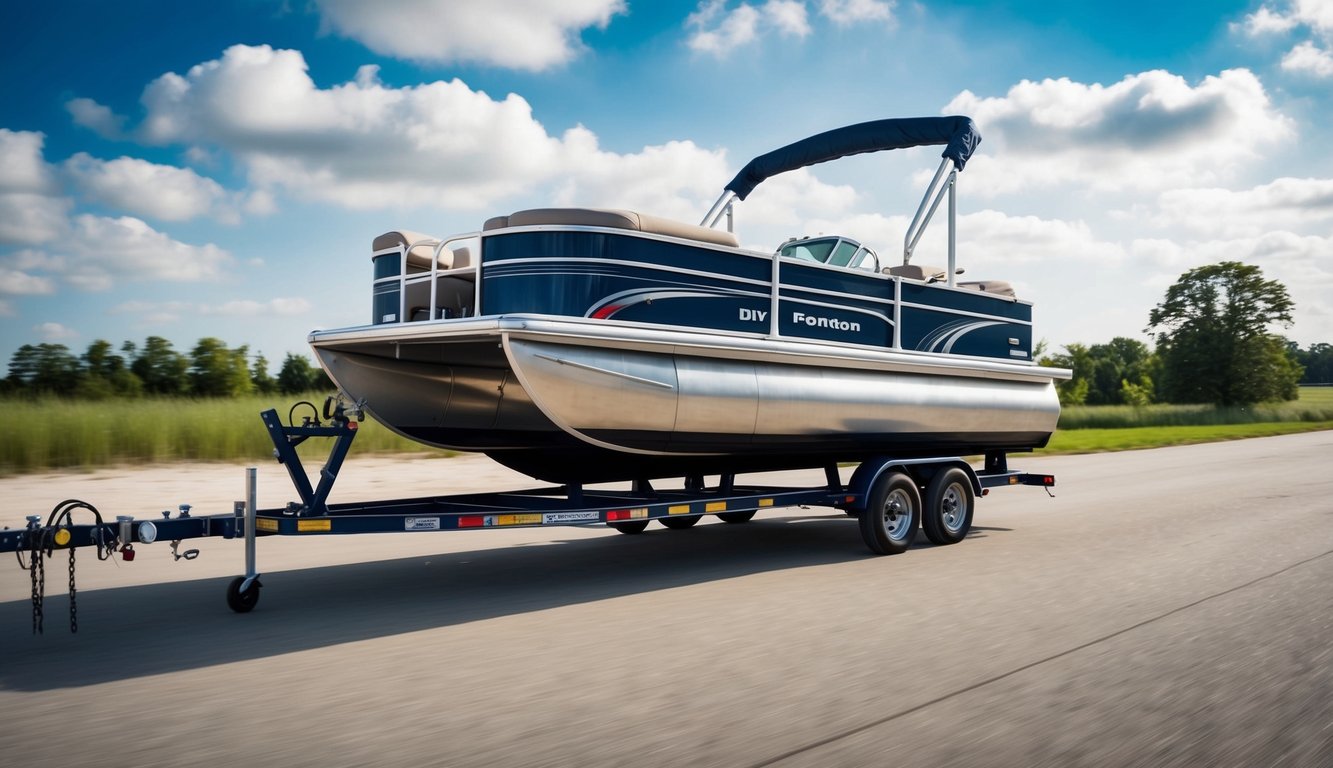
- When transporting your pontoon boat yourself, there’s a higher risk of damaging your valuable investment. DIY transport often lacks the expertise that professional transporters bring to the table.
- Improper towing techniques can lead to significant wear and tear on your pontoon boat. This is especially true if you’re new to hauling large watercraft or don’t have the right equipment.
- Your boat might suffer scratches, dents, or more serious structural damage during DIY transport. The pontoons themselves are vulnerable to road hazards that you might not anticipate without professional experience.
- Equipment failure is another concern when moving your boat yourself. A trailer malfunction or improper securing methods can result in costly repairs to your vessel.
- Without professional equipment and knowledge, you may also damage the deck or interior components of your pontoon. Remember that decks can rot and interiors can deteriorate even without transportation stress.
- The weight distribution on your trailer matters too. Experts recommend that the total weight of your boat and gear be no more than 85% of the trailer’s GVWR for safety. Exceeding this limit risks damage to both your trailer and boat.
